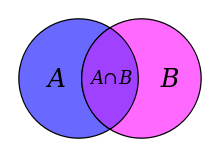Universal set
In set theory, a universal set is a set which contains all objects, including itself.[1] In set theory as usually formulated, the conception of a universal set leads to a paradox (Russell's paradox) and is consequently not allowed. However, some non-standard variants of set theory include a universal set. It is often symbolized by the Greek letter xi.
Reasons for nonexistence
Zermelo–Fraenkel set theory and related set theories, which are based on the idea of the cumulative hierarchy, do not allow for the existence of a universal set. Its existence would cause paradoxes which would make the theory inconsistent.
Russell's paradox
Russell's paradox prevents the existence of a universal set in Zermelo–Fraenkel set theory and other set theories that include Zermelo's axiom of comprehension. This axiom states that, for any formula and any set A, there exists another set
that contains exactly those elements x of A that satisfy . If a universal set V existed and the axiom of comprehension could be applied to it, then there would also exist another set , the set of all sets that do not contain themselves. However, as Bertrand Russell observed, this set is paradoxical. If it contains itself, then it should not contain itself, and vice versa. For this reason, it cannot exist.
Cantor's theorem
A second difficulty with the idea of a universal set concerns the power set of the set of all sets. Because this power set is a set of sets, it would automatically be a subset of the set of all sets, provided that both exist. However, this conflicts with Cantor's theorem that the power set of any set (whether infinite or not) always has strictly higher cardinality than the set itself.
Theories of universality
The difficulties associated with a universal set can be avoided either by using a variant of set theory in which the axiom of comprehension is restricted in some way, or by using a universal object that is not considered to be a set.
Restricted comprehension
There are set theories known to be consistent (if the usual set theory is consistent) in which the universal set V does exist (and is true). In these theories, Zermelo's axiom of comprehension does not hold in general, and the axiom of comprehension of naive set theory is restricted in a different way. A set theory containing a universal set is necessarily a non-well-founded set theory. The most widely studied set theory with a universal set is Willard Van Orman Quine’s New Foundations. Alonzo Church and Arnold Oberschelp also published work on such set theories. Church speculated that his theory might be extended in a manner consistent with Quine’s,[2] [3] but this is not possible for Oberschelp’s, since in it the singleton function is provably a set,[4] which leads immediately to paradox in New Foundations.[5] The most recent advances in this area have been made by Randall Holmes who published an online draft version of the book Elementary Set Theory with a Universal Set in 2012.[6]
Another example is positive set theory, where the axiom of comprehension is restricted to hold only for the positive formulas (formulas that do not contain negations). Such set theories are motivated by notions of closure in topology.
Universal objects that are not sets
The idea of a universal set seems intuitively desirable in the Zermelo–Fraenkel set theory, particularly because most versions of this theory do allow the use of quantifiers over all sets (see universal quantifier). One way of allowing an object that behaves similarly to a universal set, without creating paradoxes, is to describe V and similar large collections as proper classes rather than as sets. One difference between a universal set and a universal class is that the universal class does not contain itself, because proper classes cannot be elements of other classes. Russell's paradox does not apply in these theories because the axiom of comprehension operates on sets, not on classes.
The category of sets can also be considered to be a universal object that is, again, not itself a set. It has all sets as elements, and also includes arrows for all functions from one set to another. Again, it does not contain itself, because it is not itself a set.
Notes
- ↑ Forster 1995 p. 1.
- ↑ Church 1974 p. 308. See also Forster 1995 p. 136 or 2001 p. 17.
- ↑ Flash Sheridan (2016). "A Variant of Church's Set Theory with a Universal Set in which the Singleton Function is a Set" (PDF). Logique et Analyse. 59 (233). §0.2. doi:10.2143/LEA.233.0.3149532. Lay summary (PDF).
- ↑ Oberschelp 1973 p. 40.
- ↑ Holmes 1998 p. 110.
- ↑ "Overview of Randall Holmes's Home Page".
References
- Alonzo Church (1974). “Set Theory with a Universal Set,” Proceedings of the Tarski Symposium. Proceedings of Symposia in Pure Mathematics XXV, ed. L. Henkin, American Mathematical Society, pp. 297–308.
- T. E. Forster (1995). Set Theory with a Universal Set: Exploring an Untyped Universe (Oxford Logic Guides 31). Oxford University Press. ISBN 0-19-851477-8.
- T. E. Forster (2001). “Church’s Set Theory with a Universal Set.”
- Bibliography: Set Theory with a Universal Set, originated by T. E. Forster and maintained by Randall Holmes at Boise State University.
- Randall Holmes (1998). Elementary Set theory with a Universal Set, volume 10 of the Cahiers du Centre de Logique, Academia, Louvain-la-Neuve (Belgium).
- Arnold Oberschelp (1973). “Set Theory over Classes,” Dissertationes Mathematicae 106.
- Willard Van Orman Quine (1937) “New Foundations for Mathematical Logic,” American Mathematical Monthly 44, pp. 70–80.
